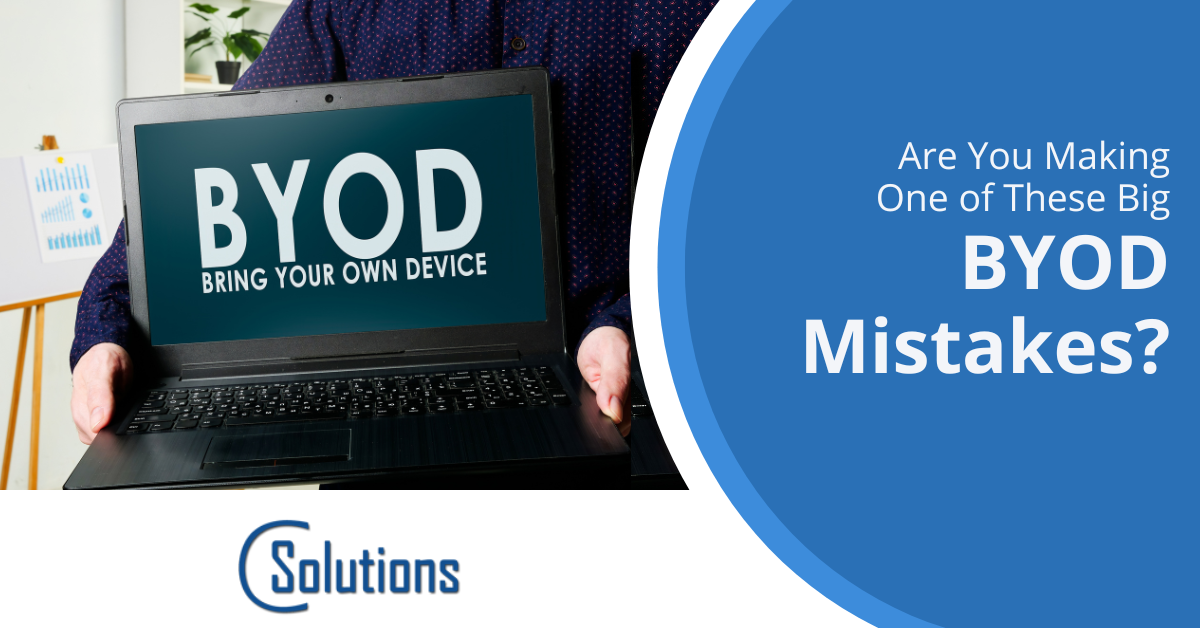Are You Making One of These Big BYOD Mistakes?

BYOD is an acronym for bring your own device, a common workplace practice in which organizations enable employees to use their own devices for work purposes as opposed to providing company laptops and mobile phones.
The BYOD trend has been accelerating for years, fuelled by improvements in the capabilities of smart phones, the move to hybrid and mobile work, and the introduction of 4G and 5G connectivity.
The Benefits of BYOD
Whether your company has officially allowed BYOD or not, chances are your employees use their own phones and laptops for work purposes at least some of the time. In fact, it’s estimated that three-quarters of employees have used their phones for work-related activities at one point or another.
At the same time, 80% of IT leaders at large companies believe that employees should be allowed to use their own devices for work purposes, citing productivity, flexibility and satisfaction as key reasons.
Another critical benefit of BYOD is cost efficiency. If your organization moves solely to a BYOD model, you will save a lot of money that would otherwise be spent on hardware.
The Risks of BYOD
For all the benefits of BYOD, it does have its risks – especially when it comes to security and compliance. Left unmanaged, BYOD quickly becomes a data security nightmare. Did you know, for example, that 97% of organizations experienced a mobile device related cyberattack in 2020?
Undoubtedly, you need a strategy in place for adopting BYOD securely. So, where do things normally go wrong? What mistakes do organizations make that lead to BYOD data breaches? Here’s everything you need to know about the top BYOD mistakes we’ve seen.
Common BYOD Mistakes To Avoid
Not Officially Enforcing A BYOD Policy
BYOD without BYOD policies is a recipe for disaster. Essentially, your BYOD policies set out guidelines and rules regarding how employees should use their personal devices for business purposes. If you fail to put this documentation in place, you are at increased risk of a data breach.
This is because BYOD isn’t as simple as saying to your employees one day: “Ok, you can use your cellphone for work.”
You need to go through a process before this happens. Each device needs to be properly checked and updated first. You’ll also likely need to install some form of mobile device management (MDM) solution on the phone for data security purposes.
Forgetting to Create Criteria For Applicable Devices
You will need to be slightly selective as to what devices you let your employees use within the BYOD policy. Devices with outdated operating systems, for example, pose a security risk, as they won’t receive regular security updates.
A Lack of Employee Security Training
When your employee uses the same device for work and play, there’s an increased likelihood that they could interact with malicious consumer applications, websites or receive phishing emails. In line with this, during the first half of 2021, there was a 161% increase in mobile phishing attacks experienced by employees.
This is why it’s so important to regularly train your employees on secure workplace practices. We advise rolling out specific training on security and BYOD, so your employees know what is expected of them and learn how to stay secure while on the web.
Not Communicating With Your Employees About Byod
Linking to training is communication. It’s not enough to set a BYOD policy and then let it gather dust on the shelf. You need to educate your employees on what the BYOD policy entails, how it works and how it impacts their devices and personal data.
For example, where you have installed an agent on your employees’ devices, you must communicate what this means and what data the agent collects. Be careful about the solution you choose, here, as certain MDM tools can be quite invasive and erode user privacy. We can help you to install an effective solution that does not compromise your people’s personal data.
Failing to Wipe Devices Before an Employee Leaves Your Company
In the world of business, employees come and go. During the exit procedure, you must ensure that you wipe all company data from your employee’s device. You can do this manually or through a remote wiping mechanism if your MDM solution features it.
It’s a must to do this. Otherwise, your employee could take confidential information with them to a new job at a competitor. Moreover, we advise implementing remote wiping in the event that an employee loses their device, too. That way, you can ensure that no data on the device is compromised, even if it’s been stolen.
Get Help Protecting Your Employee Mobile Devices Today!
C Solutions can help your Orlando area business with an affordable mobile device management system that enables better cybersecurity and data protection.
Schedule a free consultation today! Call 407-536-8381 or reach us online.
